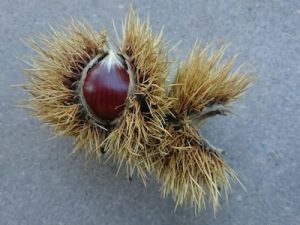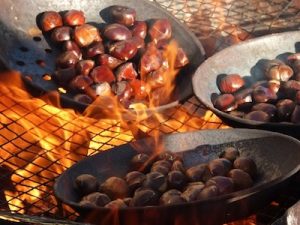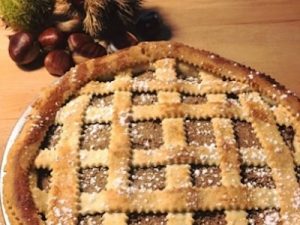Castanhas e Verao de Sao Martinho
Chestnuts and St Martins Summer

In Portugal, harvest festival, called ‘Magusto’, is celebrated on St Martins day, 11th November. Traditionally the whole family sat around an open fire, celebrating a bountiful harvest by eating roasted chestnuts, drinking new wine and other regional delicacies.
For example, In Lousã, they celebrate the honey harvest at the same time as the chestnut harvest “Feira do Mel e do Castanha”. Everyone gets involved, restaurants produce special dishes to include both foods and there is an exhibition in the town centre to taste the produce.
St Martin of Tours
The legend of St Martin says that he was a roman soldier living about AD 350. Travelling home one day, Martin came across a cold beggar dressed in rags begging in the street. He cut his cloak in half to warm up the beggar. As soon as he did, the clouds parted and the sun came out. Martin was able to travel home without needing his cloak.
That night, Jesus appeared in a dream wearing the beggars cloak and thanked Martin for giving him protection. When he woke in the morning, the cloak was repaired and was one piece again. Following this miracle, Martin left the military and joined the church. He became a Bishop and eventually one of the most revered Saints in France.
More about St Martin of Tours here https://en.wikipedia.org/wiki/Martin_of_Tours
In Portugal, early November sunshine is called “Verão de São Martinho”, St Martins summer, after the miraculous change in the weather all those centuries ago.
Chestnuts
Before Potatoes came from the new world, Chestnuts were a staple food across Europe. Alexander the Great and the Romans were probably responsible for planting the first trees in Portugal. Chestnuts trees will grow in mountainous places that cereals such as wheat won’t. As well as providing food, the wood of the Chestnut tree is a hard wood ideal for building and can last up to 1000 years.
A good Chestnut harvest meant food for the winter months for humans but also for birds, wild boar, deer, and squirrels.
How to cook Chestnuts
 To cook in the traditional way, sweet chestnuts, are scored in a cross to prevent them bursting and are then roasted for 30 minutes over an open flame to become Castanhas Assadas.
To cook in the traditional way, sweet chestnuts, are scored in a cross to prevent them bursting and are then roasted for 30 minutes over an open flame to become Castanhas Assadas.
For modern oven cooking, they can be scored and placed cut side up in a single layer on a baking sheet. Roast in the oven on 200C/400F/Gas 6 for 20 minutes. They are ready when the scored skin opens and the Chestnut inside is soft.
To microwave, chop the whole Chestnut in half, adding a couple of spoons of water, cover and zap for 60 – 90 seconds until soft.
If you have a very bountiful harvest, Chestnuts can be pressured cooked in their shells for 5 minutes and frozen in bags. When thawed they can be used as is or dried to make flour.
Chestnuts are used in products from Beer to Yoghurts but more commonly ground into flour and used in baking. They are low in cholesterol with no gluten or fat. Bread made with Chestnut flour will be flat as the lack of gluten means it won’t rise. But Chestnuts are adaptable and work well in sweet and savoury dishes.
Chestnut Flour
Once the chestnuts have been scored and roasted, peel off the skin while they are still warm. If the skin cools down and becomes brittle, 30 seconds in the microwave will soften it again. Slice the whole nuts in half to speed up the drying process. Spread on a sheet and place in a dehydrator for 12-24 hours or on your ovens lowest setting.
They are dried out when you are unable to break the pieces of nut in half with your fingers. Use a grinder or blender to grind the nut pieces into flour. Keep the flour frozen or in the fridge and it will last for up to 6 months.
Chestnut Tart
From the Pure Portugal Facebook group, here is the popular Chestnut Tart Recipe thanks to Mark Walz and Mark Buttigieg
Prepare the chestnuts:
Using a sharp knife cut a cross on each chestnut shell. Place in a saucepan cover with water and boil for around 10 minutes. Test one to check how soft the flesh is and should be mushy. Drain and cool, then remove shell and if possible the inner skin. Leave aside covered.
Prepare the Shortcrust pastry:
Sift 250 g plain flour and a pinch of salt into a bowl and add2 tablespoons of castor sugar. Rub in 115 g of cold butter till mixture resembles fine breadcrumbs. Mix in around 85 mils of cold water or a little more to form a dough. I cheat and place all the ingredients except the water into a food processor and wiz till the mixture looks like wet sand. Then with the processor still running I add the water till it is mixed.
Wrap dough in cling film or a plastic bag and leave in the frig for 30 minutes or more. Or use store bought shortcrust whatever you fancy
Chestnut Fillings:
Into a food processor add the following ingredients
500 g de shelled Chestnuts
A good tablespoon or orange marmalade
60 g grated chocolate (or a little more)
Grated rind of an orange
Juice of an orange
2 tablespoons of castor sugar
I tablespoon honey (optional)
2 tablespoons of vermouth or rum (or brandy or…)
Process all the ingredients till it resembles thick peanut butter. Sneak a taste and add a little of whatever you think it needs more of. The pastry recipe makes enough for a covered pie in 9in pastry tin. Roll pastry and cover base of tin. Add the filling and spread evenly. With a pastry cutter cut strips and decorate top of pie. Brush the pastry strips with milk and carefully sprinkle castor sugar onto the strips. Bake in a preheated oven 180 C fan force or 200 C normal and check after 20 mins and increase baking by 5 mins till pie is baked.
Let cool and enjoy.

Do you have any Chestnut recipes? Email team@pureportugal.co.uk and tell us. We’ll include them in a future blog post.





